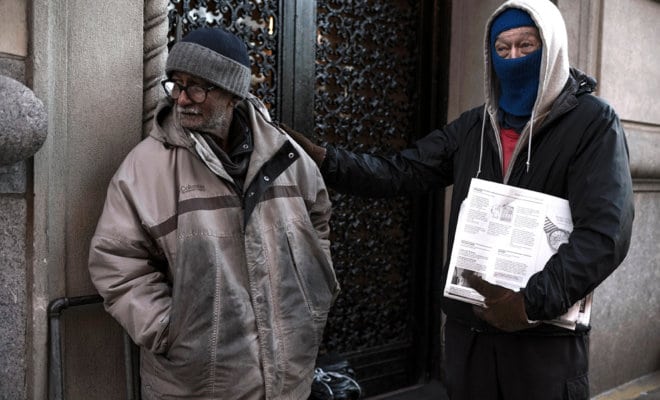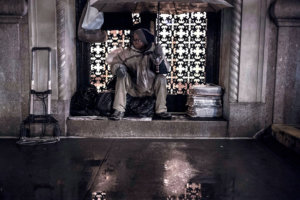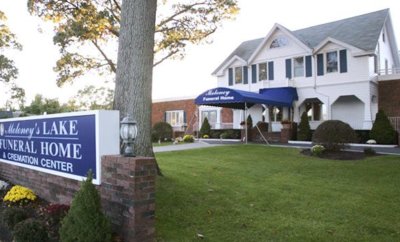Books
Last of The Newsies

Ram Badan Singh, left, a sidewalk newspaper hawker, with one of his regular customers in New York. While Singh’s sales of The New York Times have dwindled to about 80 a day from nearly 800, he outperforms many brick-and-mortar newsstands.
Photo: Joseph Michael Lopez/ The New York Times
Ram Badan Singh, a sidewalk newspaper hawker, has been working at the same spot in New York for 36 years.
Long before dawn on a wind-whipped April night, the only thing stirring at the corner of Central Park West and 86th Street was a slight figure in boyishly oversize attire — ink-stained parka, baggy pants, owlish eyeglasses — that nearly hid him as he fussed with a stack of newspapers.
He certainly seemed invisible to the gathering parade of passers-by, ears plugged with speakers or eyes fixed on tiny screens: the runners around 5:30 a.m., the dog walkers at 6.
Then, slowly, his people arrived, ambling up the sidewalk or pulling cars to the curb to press dollar bills into his palm, take the morning paper and check on the whiskered face that poked out of the parka. “How’s it going, Singh?” they asked. “What’s in the news today, Singh?”
Newsprint is endangered. Retail has fled to the internet. Cash is becoming quaint. Yet Ram Badan Singh, who left a job as a civil engineer in India to come to New York at age 42, is still scraping together a living out of all three, in the same spot where he began 36 years ago.
Except for three brief trips back to India in the 1980s and 1990s, he has sold newspapers outside the 86th Street subway station every night and morning, in blizzards and rainstorms and heat waves, with no newsstand for protection and not a single day off. There is every reason to expect he will turn 81, in July, at his chosen perch on the side doorstep of a grand prewar apartment building that calls itself, without apparent irony, the White House.
“So many hurricanes I can remember,” he said with a rueful chuckle. “Three hundred and 65 days, without fail.”
He has an uneasy relationship with this White House, which has alternately welcomed and shunned him; the current administration has restricted entry to a foyer where Singh would shelter on the coldest and wettest nights. February’s relentless chill has been especially punishing.
But there are two good reasons Singh has prevailed so long at this Upper West Side corner: his iron devotion to the job, and his customers’ devotion to him.
One by one over the years, they have each made the silent decision to continue buying from him, paying full newsstand prices and often walking blocks out of their way, rather than reading the news online or getting home delivery.
They fetch his takeout meals and draw him into conversation. They buy him warm coats and scarves and sneakers. Some trade emails about his health, which has been remarkably robust despite an occasional scare. (“He didn’t get to the corner until 5:30 instead of his usual 3,” a neighbor messaged to another on a morning in 2014. “He said he has to down cough syrup twice in the night now, and this time it knocked him out.”)
A physician in the White House arranged for a free chest X-ray. The superintendent at another building lets Singh into the basement for bathroom breaks. Customers stand guard over his papers until he returns.
A man of quiet ways, Singh can be gloomy and taciturn one day, lively and opinionated the next; his mood varies with the weather and the headlines. Yet his regulars, most of them middle-aged or older, speak of him with warmth, and something more.
“I’ve stayed with Singh out of loyalty,” said Ken Coughlin, who runs a legal-information website and has been buying The New York Times from him every day for at least 20 years, at a cost now of about $1,250 a year. “He’s a fixture in the neighborhood, a fixture in my life. I want to support him.”
Lee Herman, a curator emeritus at the American Museum of Natural History, has been a patron since Singh first showed up. “You see this guy, with wind chill of 11 below, out there selling papers,” Herman said. “He’s got a life that’s extraordinary — what he has to go through to live.”
These neighbors know little about that life, or one another’s, but Singh knows all their preferences and quirks. He notices when they miss a day, and offers to save their papers. He serves noncustomers, too — clearing trash from the sidewalk, warning subway riders when trains aren’t running, feeding the birds and dogs (“my other customers,” he calls them), holding the door when White House residents need a hand.
His own home is a rent-controlled apartment in an SRO hotel 20 blocks north, where he lives alone. He has no family in the United States. For Singh, it’s all about the corner. “If I am not there for my neighbors, then I feel bad,” he said. “I like my customers. I do my duty.”
Singh was born in Bihar, in northeastern India, the third of six children. His father died when he was 8, and while top grades won him scholarships, he had to work constantly, he said, to pay for books and other expenses.
He earned a master’s degree in engineering, then landed a job with the state. But he grew disillusioned, he said, with the bribery and official corruption he saw around him. “I was the only honest guy,” he said.
Singh arrived at Kennedy International Airport in 1980 with $300 and the address of a friend’s friend, who helped him get settled. “I was thinking, the most honest people must be in America,” he said.
He found out quickly that his Indian engineering degree had little currency in this country. He worked retail jobs before approaching The Times, where a manager suggested he sell at 262 Central Park West, the White House. Singh started on April 23, 1982.
At first he delivered papers inside the building to customers who included A.M. Rosenthal, then The Times’ executive editor. As sales fell, Singh retreated to the foyer. But in 2010, he was banished even from there, neighbors say; bedbugs had turned up in the building, and the management blamed Singh.
He fiercely denied that, and his defenders petitioned the co-op board to allow him back in. But since then his access to the foyer has been hit or miss: Although doormen let Singh inside during this winter’s worst nights, he was ousted again in February. “So mean,” he lamented to friends.
Singh’s workday begins around 10 p.m., after he rises from sleep and takes the bus to 86th Street, retiring to the nearby basement to bundle the previous morning’s unsold papers for pickup and assemble preprinted sections for the Sunday editions. He is back out on the sidewalk by 2 a.m. for the first of several newspaper deliveries.
Though most customers won’t arrive for hours, he feels he has to be there, fearing that the bundles will be stolen — as they were once. At 10 a.m., he heads to a cafe to eat, then home to a deep sleep.
Singh’s endurance embodies one of New Yorkers’ favorite truisms: that their big, reputedly heartless city is really a collection of small, caring villages. It also attests to a less comforting truth: the city’s blunt juxtapositions of the wealthy and the not-so — like Singh, who makes about $25 on a weekday ($40 on a Sunday), working in the shadows of some of the most expensive real estate on the planet.
For some Upper West Siders, he is a reminder of a less Darwinian city. “It’s like he’s part of the old-time New York where you have other people you look out for,” said Maxine Davis, a Feldenkrais practitioner who has lived in the area since 1979. “Young people come here and make a fortune and stay for two or three years and then move out. Who makes up the long-term neighborhood? I have a strong sense that you need that.”
Singh is also among the last of a vanishing breed: the sidewalk newspaper hawker. While his Times sales have dwindled to about 80 a day from nearly 800, he outperforms many brick-and-mortar newsstands. Mark Weitzel, who heads print distribution for The Times, said there are about 130 individuals selling papers on New York streets, but most work for larger vendors and handle fewer copies than Singh, who buys his papers directly from The Times and other companies.
Singh has offset sinking sales of New York papers by taking on several other publications, including The Washington Post, Financial Times and even a copy of a Polish-American daily, Super Express USA, that he carries for a doorman down the block. (A filmmaker chronicled Singh’s daily routine in 2015 for a short documentary titled “Singh.”)

Ram Badan Singh waits for his newspaper deliveries in New York. Photo: Joseph Michael Lopez/ The New York Times
John R. MacArthur, the publisher of Harper’s Magazine, lives in the West 70s but was taking his daughter to preschool 13 years ago when he spotted the stack of papers, nearly as tall as the man beside them. “Then I noticed he was reading the papers thoroughly himself. ‘Look at this!’ he’d say, and point out a headline,” MacArthur said. “He read widely, across several different newspapers. So I became an addict, a fan.”
He likes to get Singh talking about current events. “The thing with him is that he’s alternately upbeat and very depressed about the state of the world,” MacArthur said. “To the extent that his emotions fluctuate with the news, I find this very useful — he’s a sort of weather vane for me.”
But MacArthur is also concerned for him, and the future of print. “I’m very pro-paper,” he said. “I worry whether he can survive financially.”
A more immediate threat looms: The 86th Street subway station is scheduled to close from June to October for renovations, and neighbors fear that the drop in foot traffic will doom Singh’s business. Coughlin, who sits on the local community board, has asked the Metropolitan Transportation Authority to help compensate the news vendor. The agency responded that it would “work actively and outside the box to help minimize any impacts for businesses and residents.”
Word of the closing drew a shrug from Singh. “I will survive, somehow,” he said. “So many botherations, for my whole life.”
A U.S. citizen since 1985, Singh votes just as religiously, and pays his self-employment taxes quarterly. But some aspects of America, including that other White House, have disappointed him. “I am not so much happy with the honesty here,” he said. “I don’t like these corrupt people.”
With only rent, meals and the bus as expenses, he has saved enough to send money to relatives in India. He has no computer or cellphone, but calls his nephew Poona every few weeks from a nearby deli. “Every time they are asking me, ‘Come back,’” he said. “I don’t know.”
Singh appears to relish his autonomy. Neighbors ask one another if he has the means to retire in New York; a few have spoken about leaving him something in their wills — the assumption being that he will outlast them all. For now, Singh’s plan is simply to keep working.
He is a bit less than honest, though, with the people who sell him his papers, worrying that they will decide he is too old.
“I tell them I am 62,” he said, grinning slyly. “That way I have three more years before I have to retire.”
Jack Begg contributed reporting
© 2018 New York Times News Service




You must be logged in to post a comment Login